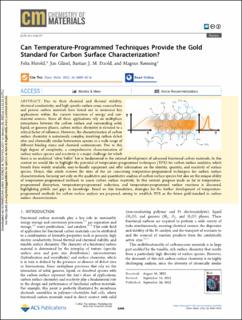| dc.description.abstract | Due to their chemical and thermal stability, electrical conductivity, and high specific surface areas, nanocarbons and porous carbon materials have found use in numerous key applications within the current transition of energy and raw-material sources. Since all these applications rely on multiphase interactions between the carbon surface and surrounding solid, liquid, or gaseous phases, carbon surface chemistry is elevated to a critical factor of influence. However, the characterization of carbon surface chemistry is notoriously complex, involving carbon defect sites and chemically similar heteroatom species in a wide range of different binding states and chemical environments. Due to this high degree of complexity, a comprehensive characterization of carbon surface species and reactivity is a major challenge for which there is no analytical “silver bullet” but is fundamental to the rational development of advanced functional carbon materials. In this context we would like to highlight the potential of temperature-programmed techniques (TPX) for carbon surface analytics, which benefit from widely available, easy-to-handle equipment and offer information on the identity, quantity, and reactivity of surface species. Hence, this article reviews the state of the art concerning temperature-programmed techniques for carbon surface characterization, focusing not only on the qualitative and quantitative analysis of carbon surface species but also on the unique ability of temperature-programmed methods to assess carbon surface reactivity. In this context, progress made so far in temperature-programmed desorption, temperature-programmed reduction, and temperature-programmed surface reactions is discussed, highlighting pitfalls and gaps in knowledge. Based on this foundation, strategies for the further development of temperature-programmed methods for carbon surface analysis are proposed, aiming to establish TPX as the future gold-standard in carbon surface characterization. | en_US |

